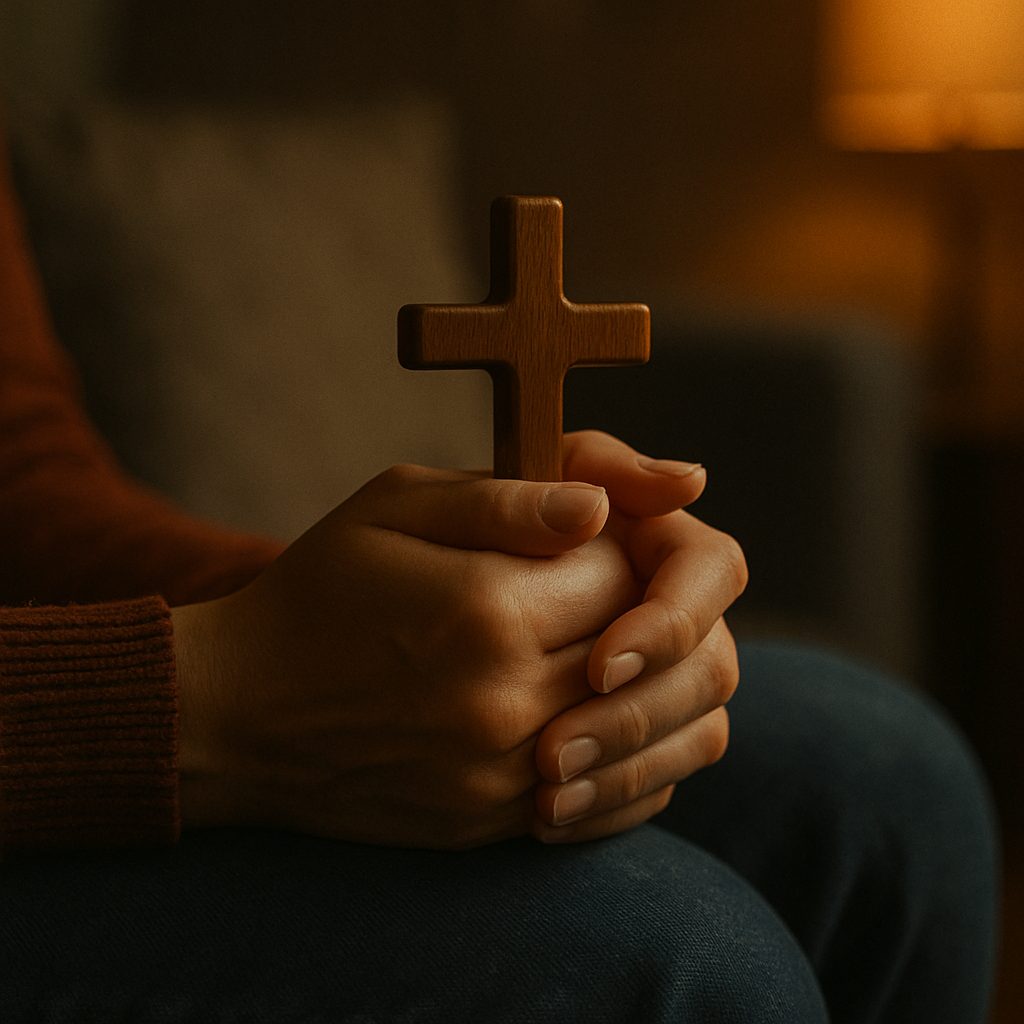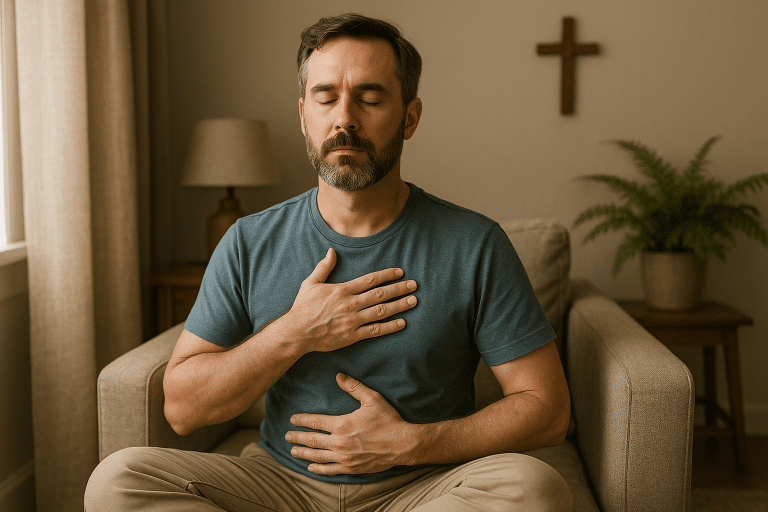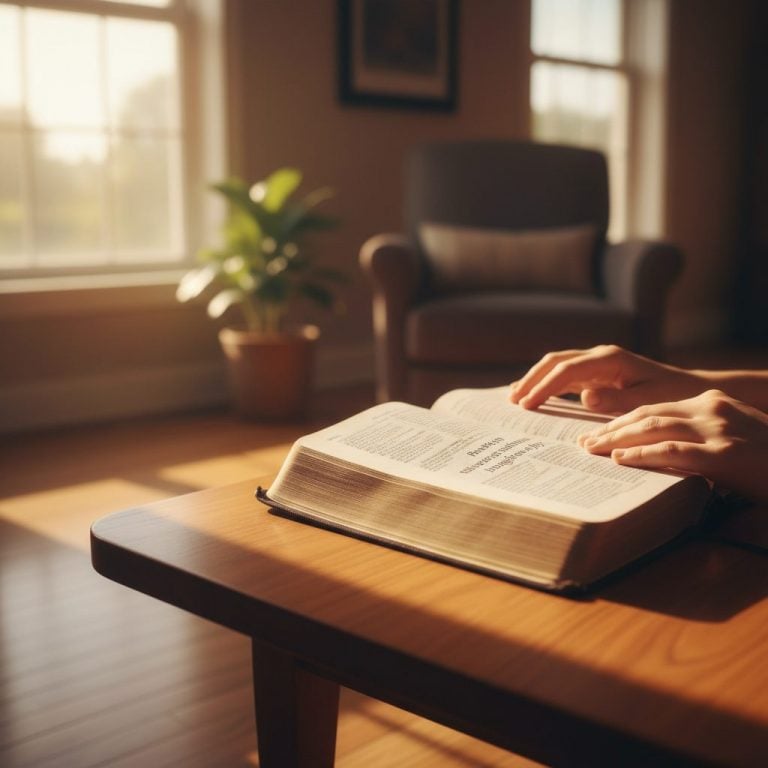Grounding Techniques for Anxiety During a Panic Attack
Estimated reading time: 7 minutes
Introduction
Panic can feel like a wave that will sweep you away. However, you can ride that wave with simple skills that settle your nervous system and anchor you in God’s presence. In moments of racing heart, shortness of breath, and spiraling thoughts, grounding techniques for anxiety during a panic attack help you return to the present, breathe slowly, and remember what is true. Moreover, they work best when you practice them before you need them. Because you are body and soul, we will integrate clinical tools with prayer, Scripture, and wise next steps.
Many people experience at least one panic attack in life, and that fact alone can reduce shame. For plain‑language medical guidance on symptoms and causes, see the Cleveland Clinic’s overview of panic attacks, including self‑care and treatment options (Cleveland Clinic). Additionally, you can learn a one‑minute breathing reset that stimulates the body’s natural relaxation response (Harvard Health).
Why These Grounding Techniques Work In A Panic Attack
When panic surges, your brain triggers a false alarm. Consequently, adrenaline rises, breathing becomes shallow, and muscles tense for “fight or flight.” Because this reaction is automatic, you cannot “think” your way out at first. Instead, you use your body to calm your body. Slow breathing, sensory focus, and gentle movement send a safety message along the vagus nerve to your heart and lungs. Therefore, your system shifts from threat to rest, often within minutes.
At the same time, faith reframes fear and provides anxiety grounding. Scripture invites you to cast your anxiety on God because He cares for you (1 Peter 5:7). Therefore, you can pray short breath prayers—“Be still… and know that I am God” (Psalm 46:10)—while you exhale. As you practice, you build confidence that symptoms are temporary, uncomfortable, and survivable. Furthermore, medical sources affirm that acknowledging “this is a panic attack, and it will pass” reduces the terror that fuels the loop (Cleveland Clinic).
For deeper background on why sensory grounding works and how to practice it step‑by‑step, this practical overview details the popular 5‑4‑3‑2‑1 method (Verywell Mind). Likewise, if caffeine, fatigue, or dehydration increase your vulnerability, address those triggers ahead of time so the body can settle more easily.
Evidence‑Based Grounding Techniques
First, breathe low and slow. Inhale through your nose for a count of four and let your belly rise for anxiety grounding. Then exhale gently through pursed lips for a count of six to eight. Because longer exhales nudge the parasympathetic system, the heart rate drops and dizziness eases. As Harvard’s guidance explains, diaphragmatic breathing can flip the body from “fight or flight” into a relaxation response (Harvard Health).
Second, use 5‑4‑3‑2‑1. Name five things you see, four you feel, three you hear, two you smell, and one you taste. Because attention follows instruction, your mind returns to the present as your breath slows (Verywell Mind). For a quick primer on grounding in daily life, explore our concise introduction to the practice on Craig Chamberlin’s site (What Is Grounding?).
Third, add touch and movement. Hold a cool glass, splash water on your hands, or grip a pocket cross. Then stretch your shoulders or pace slowly while noticing your footsteps. Additionally, progressive muscle relaxation—tense and release toes, calves, hands, and face—reduces tension and redirects attention. For a faith‑friendly breath prayer walkthrough you can memorize, see this simple practice guide (Breath Prayer Guide).

Spiritual Grounding For Panic And Anxiety
Because you belong to Christ, you have more than techniques; you have a Person. Therefore, combine each exercise with a short prayer: “Jesus, calm me,” or “Lord, hold me fast.” Research on religious coping suggests prayer can reduce reactivity by quieting the stress response. For an accessible summary of this effect, see this overview of the science of prayer (APS). Meanwhile, Scripture provides truth to replace catastrophic thoughts: Isaiah 41:10, Psalm 56:3‑4, John 14:27, and 2 Timothy 1:7. Additionally, worship and thanksgiving shift attention from fear to God’s character.
To build a daily rhythm that lowers your baseline anxiety, practice a short morning meditation on God’s presence. Then rehearse one promise throughout the day. For a hands‑on devotional that pairs breath, Scripture, and reflection, review this practical Christian meditation piece (Christian Meditation For Anxiety). Furthermore, reduce stimulants that agitate the nervous system; many believers notice less reactivity when they limit caffeine. For a faith‑savvy look at that connection, read this guide (Caffeine And Anxiety).
Professional Help, Medicine, And Anxiety Grounding
Sometimes symptoms become overwhelming despite faithful practice. In that case, seek a clinician who can assess for panic disorder and coach skills like cognitive‑behavioral therapy. According to medical guidelines, CBT—including interoceptive exposure—reduces the fear of sensations and cuts attack frequency (Mayo Clinic). Additionally, your doctor may discuss medicines such as SSRIs for long‑term stabilization, or short‑term options used sparingly. For a quick, plain‑English review of options and timing, consult the Cleveland Clinic’s treatment page (Cleveland Clinic).
Christians can receive therapy and medication as gifts of common grace while continuing to pray and grow. Therefore, you can view medical care like any other stewardship of your body. Meanwhile, keep practicing grounding techniques for anxiety during a panic attack so your nervous system learns a faster return to calm. Likewise, ask trusted friends or church leaders to support you, because shared burdens lighten fear.

Amazon Product Recommendation
Practical tools can make grounding easier to practice on the spot. Because affiliate links support this ministry at no extra cost, we mark them as sponsored. Choose one or two items you can keep nearby and rehearse with daily, so they feel natural when stress hits.
Pocket Cross Or Pendant: A small cross gives your fingers a familiar anchor while you pray. See options here: pocket cross necklaces. Stress Ball Or Therapy Putty: Squeezing and releasing helps discharge tension and focus attention; browse stress balls. Instant Cold Packs: Brief cold can interrupt spirals and bring you back to the present; consider instant cold packs. Noise‑Reducing Earbuds: Quieter input reduces sensory overload during recovery; compare noise‑canceling earbuds. Guided Prayer Journal: Writing anchors thoughts and invites gratitude; explore guided prayer journals.
Before purchasing, practice the skills daily without tools so you rely on your breath, senses, and the Lord first. Then add one aid that serves—not replaces—your growing confidence. Furthermore, consider storing a mini kit in your bag with a cross, journal, and small water bottle for quick resets.
Conclusion: Living The Peace Of Christ
You are not alone, and you are not powerless. With practice, grounding techniques for anxiety during a panic attack become reflexes that help your body settle while your heart turns toward Jesus. Therefore, breathe low and slow, name what is real, and pray short prayers of trust. As you train these responses day by day, episodes grow shorter and less frightening. Additionally, wise counseling, community support, and medical care can accelerate recovery.
Finally, remember Christ’s promise: “My peace I give to you… do not be afraid” (John 14:27). Because His presence is steady, you can take heart even when fear shouts. Consequently, every small victory becomes a testimony of grace you can share with others who struggle.






